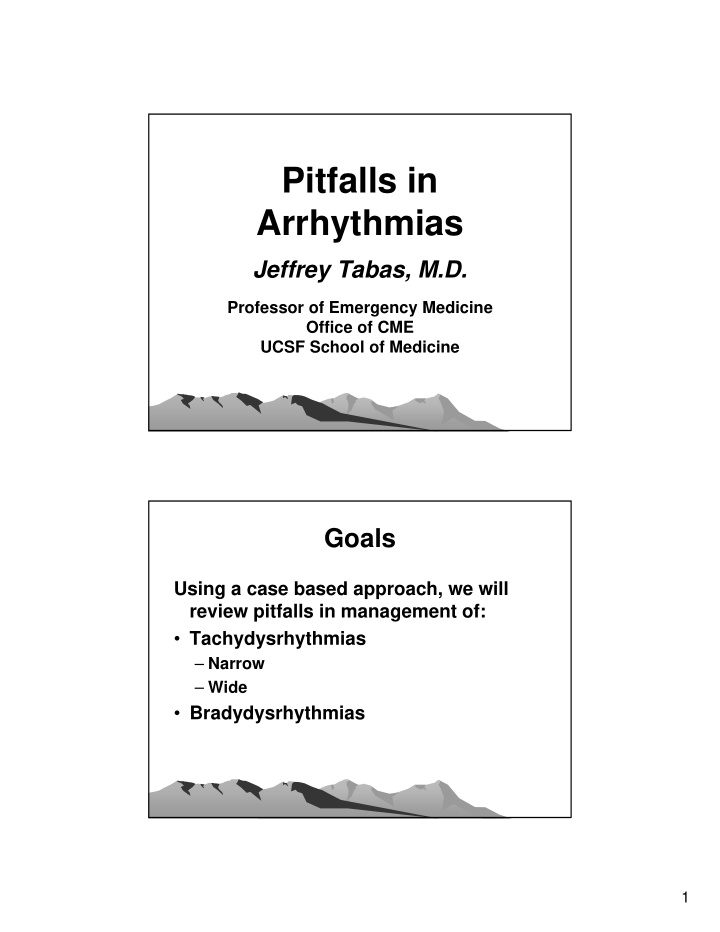



Pitfalls in Arrhythmias Jeffrey Tabas, M.D. Professor of Emergency Medicine Office of CME UCSF School of Medicine Goals Using a case based approach, we will review pitfalls in management of: • Tachydysrhythmias – Narrow – Wide • Bradydysrhythmias 1
Background 2010 ACLS Guidelines Background Narrow Complex Tachycardia 2
Background Narrow Complex Tachycardia Regular – SVT • Adenosine preferred • Beta blocker, CaCB if needed Irregular – Atrial Fib • Beta blocker • CaCB • Amiodarone • Procainamide Background Regular NCT Adenosine • 6 – 12 mg IV • Maximize delivery • Beware with dipyridamole (Aggrenox), carbamezipine 3
Background Afib and Aflutter Metoprolol • 5 mg IV Q5 mins x 3 then oral dose • Causes hypotension, bronchospasm Diltiazem • 20 mg IV over 2 min, repeat Q10-15 min • 10 mg IV if at all tenous!!!! • 60 mg po or IV drip • Causes hypotension Background Afib and Aflutter Amiodarone (o.k. if wide) • 150 mg over 10 mins • 1 mg/min infusion • Causes hypotension (less than others) Procainamide for conversion (best for wide) • 1 gm over 1 hour • Causes hypotension and prolongs QT 4
Background Wide Complex Tachycardia Background Regular WCT • Adenosine • Amiodarone • Procainamide 5
Bradycardia with Pulse 1
Case #1 A 70 y.o. male is brought in by ambulance from nursing facility with supraventricular tachycardia. Drinks a lot of coffee. Field vitals are HR =150, BP = 88/30. Paramedics tried 6 mg and 12 mg of adenosine unsuccessfully.
Case #2 Case #2 A 50 y.o y.o. male is BIBA with palpitations. He was noted to have intermitt . male is BIBA with palpitations. He was noted to have intermittent ent VTach VTach. . A 50 Because he was Because he was “ “semi semi- -stable stable” ” in the field, no intervention was given. in the field, no intervention was given. ED vital signs were: HR = 200, SBP = 90, RR = 18, Afebrile Afebrile ED vital signs were: HR = 200, SBP = 90, RR = 18, 26b. 50 y.o BIBA w/ near syncope. His exam was significant for difficult access due to extensive His exam was significant for difficult access due to extensive hx hx of IDU of IDU
Case # 3 Case # 3 A 25 y.o y.o. male presents with palpitations / pain radiating to left neck. . male presents with palpitations / pain radiating to left neck. One similar One similar A 25 episode in Mexico. Told that if recurrent, he should cough or mimic having a BM. mic having a BM. episode in Mexico. Told that if recurrent, he should cough or mi
Case #4 Case #4 A 50 y.o y.o. male presents to the ED feeling weak. . male presents to the ED feeling weak. A 50 Initial vitals show: HR = 50, BP = 80/50 Initial vitals show: HR = 50, BP = 80/50
Bibliography • Anderson JL, et al. Management of patients with atrial fibrillation: a report of the American College of Cardiology/ American Heart Association Task Force on Practice Guidelines. J Am Coll Cardiol. 2013 May 7;61(18):1935-44. Bibliography • Neumar RW, et al. Part 8: adult advanced cardiovascular life support: 2010 American Heart Association Guidelines for Cardiopulmonary Resuscitation and Emergency Cardiovascular Care. Circulation. 2010 Nov 2;122(18 Suppl 3):S729-67 1
Bibliography • Electrocardiography in Emergency Medicine. Editors: Mattu A, Tabas J, and Barish R. ACEP Publishing 2007. 2
Recommend
More recommend